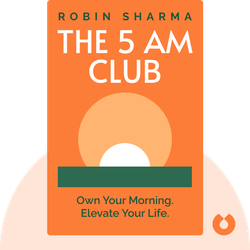Try Blinkist to get the key ideas from 7,000+ bestselling nonfiction titles and podcasts. Listen or read in just 15 minutes.
Start your free trial
Blink 3 of 8 - The 5 AM Club
by Robin Sharma

10 Steps to Infuse Well-Being and Vitality into Any Organization
Workplace Wellness that Works by Laura Putnam is a guide to creating a healthy, engaged, and productive workplace. It offers practical tips and case studies for implementing wellness programs that benefit both employees and employers.
What do you associate with a healthy workplace? Picking up the occasional apple from the break room? David from Accounts trying to enlighten you on the perils of cigarette smoke?
Workplace wellness is much more than that: it’s about enjoying your work environment, moving around more and building meaningful connections with other people.
That sounds great, but how do you get there? By instigating a change process. When you take this initiative, you can become an agent of change for your workplace. This means understanding the reason for change and communicating it to others.
Agents of change know their inner why – the reason underpinning the change – and this helps make them authentic, persuasive leaders of the process.
Take Shane Valentine, who teaches for Kids Cook with Heart, a program offering cooking lessons to school children. Valentine’s inner why is that almost no children in the United States meet the American Heart Association’s Life’s Simple 7 criteria for a healthy heart. In response to this, his program specifically addresses the criteria for a healthy diet.
Once you have a why, you’ll need people to listen. Using metaphors and emotions is an effective way of communicating your message. To gain followers, you should focus on relating stories rather than regurgitating statistics. Start by building your own story bank, a collection of meaningful stories in your head.
The key is to make sure you embody your story. If Valentine were to star in a commercial for McDonald’s, his kids cooking program would suddenly lose credibility!
As a next step, you’ll need to build a strong case to convince your coworkers of the need to improve workplace wellness.
One approach could be to highlight any monetary gains that could be achieved by implementing workplace wellness. Take presenteeism, a money-draining phenomenon that occurs when your employees are at work but aren’t fully present, i.e., they’re either not working effectively or not working at all. According to a study at Bank One, 63 percent of costs connected with poor employee health are caused by presenteeism.



Workplace Wellness That Works (2015) provides a refreshing take on how to create more well-being in any organization. It offers a 10-step guide packed with practical examples from the business world on how to initiate, expand and sustain your well-being movement.
Workplace Wellness that Works (2015) is a comprehensive guide to creating a healthier and more productive work environment. Here's why this book is worth reading:
Your task is to courageously move forward with sparking a movement of well-being within your organization.

It's highly addictive to get core insights on personally relevant topics without repetition or triviality. Added to that the apps ability to suggest kindred interests opens up a foundation of knowledge.
Great app. Good selection of book summaries you can read or listen to while commuting. Instead of scrolling through your social media news feed, this is a much better way to spend your spare time in my opinion.
Life changing. The concept of being able to grasp a book's main point in such a short time truly opens multiple opportunities to grow every area of your life at a faster rate.
Great app. Addicting. Perfect for wait times, morning coffee, evening before bed. Extremely well written, thorough, easy to use.
Try Blinkist to get the key ideas from 7,000+ bestselling nonfiction titles and podcasts. Listen or read in just 15 minutes.
Start your free trial
Blink 3 of 8 - The 5 AM Club
by Robin Sharma
What is the main message of Workplace Wellness that Works?
The main message of Workplace Wellness that Works is that creating a healthy workplace is essential for employee well-being and organizational success.
How long does it take to read Workplace Wellness that Works?
The reading time for Workplace Wellness that Works varies depending on the reader's speed, but it typically takes several hours. However, the Blinkist summary can be read in just 15 minutes.
Is Workplace Wellness that Works a good book? Is it worth reading?
Workplace Wellness that Works is worth reading as it provides practical insights and strategies for improving workplace wellness, benefiting both individuals and organizations.
Who is the author of Workplace Wellness that Works?
The author of Workplace Wellness that Works is Laura Putnam.